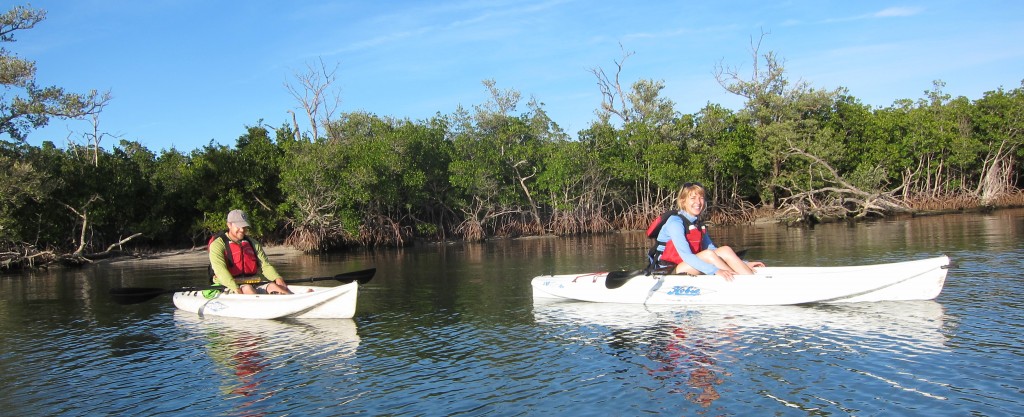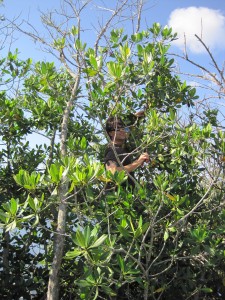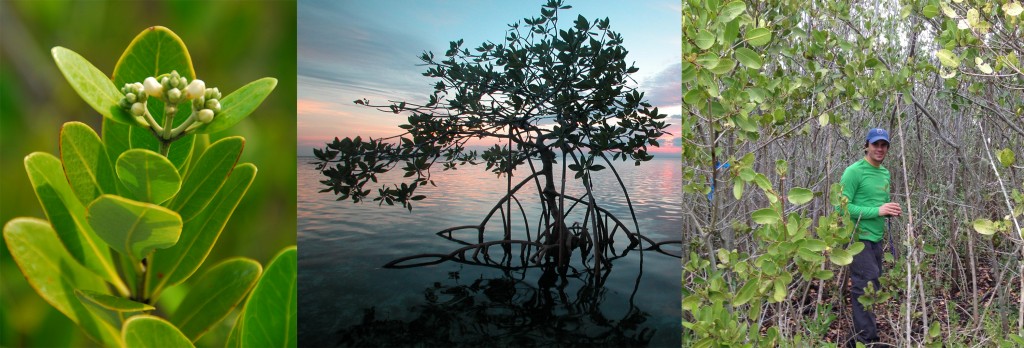by Kristen Minogue
Deep in the Florida swamps, black, white and red mangrove trees have lived together for thousands of years. But warmer winters are pulling the ecological fellowship apart, creating a new landscape in the north.
The story begins decades ago. Once, when Florida winters were chillier, mangroves remained trapped in the subtropics. As the climate warmed, Smithsonian ecologists discovered that fewer cold snaps were empowering mangroves to push north. But the trees aren’t moving in sync. Black mangroves have outstripped their cousins, passing St. Augustine, while white mangroves are lagging almost 30 miles behind. Until now, there weren’t any hard data explaining why.
“You might expect them to all be moving together in concert, but that wasn’t what we were finding,” said Susan Cook-Patton, a research associate at the Smithsonian Environmental Research Center and lead author of a new study published in April in Functional Ecology. “It seems like the black mangroves are moving a lot faster.”
Mangroves aren’t related the way oaks, hickories and other tree groups are. Florida’s big three—black, white and red—aren’t even in the same family. “They look different,” said Cook-Patton. “The reds have these huge, big, shiny leaves, the blacks are dense and tough-looking, and the whites are the lettuce of the group, kind of wimpy looking.”
Environment, not shared ancestry, defines them. “Mangroves” refers to just about any tree that can survive in flooded soils with lots of salt and little to no oxygen. They’ve evolved a myriad of ways to deal with frequent flooding, from arch-like roots above ground to underwater roots resembling snorkel tubes. But as far as familial relationships go, mangroves are less like cousins living under the same roof, and more like college students sharing a fraternity house.
The question was why black mangroves had such a commanding lead. Ecologists suspected the black mangroves might be better equipped to deal with colder temperatures up north, but there were no data comparing the different species’ freeze tolerance.
To find answers, Cook-Patton and fellow Smithsonian ecologists John Parker and Michael Lehmann trekked through the swamps. First they collected mangrove branches and seedlings from all across the 125-mile coastline Florida mangroves occupy. Then, in a combination lab-garden experiment, they put half the samples through a deep freeze (25°F) for four hours and planted all of the seedlings in the same garden.
The cold barely fazed the black mangroves. They proved toughest by almost every standard: seedling survival after freezing, biomass, even how well adult mangroves photosynthesized. Red mangroves pulled in a close second. Although most red mangrove seedlings survived under normal conditions, they fell short in the cold. Less than half the white mangroves seedlings survived the four-hour winter.
Cold tolerance may not be the only deciding force. Age could make a difference too, according to Candy Feller, who has studied mangroves for over 20 years at the Smithsonian Environmental Research Center. When a hard freeze hits an adult mangrove, the top may die. But the roots of black and white mangroves survive, sending out shoots to form a new tree.
And there’s another factor at play. The team discovered mangroves of all three species that made it farther north had leaves that were denser, tougher and perhaps all-out better equipped to handle cold than their southern brethren. It would seem the rigors of northern living can bolster even the fragile white mangroves.
That said, the strength of black mangroves gives them a hefty advantage. “Even burning doesn’t kill them,” Feller said. “They have quite a lot of reserves, and they can come back from freezing and fire.”
Blessings Beneath the Surface

Susan Cook-Patton (right) and Michael Lehmann kayak through mangrove swamps in Fort Pierce, Fla. (SERC)
The transformation won’t happen overnight. A mangrove can take 10 years to grow into a sizable tree, and for now black mangroves remain a minority in the vast northern Florida salt marshes. “It takes a long time for the whole system to switch over, probably decades,” said Feller.
While mangroves may not get a warm welcome when they arrive—they block shorelines, and their maze-like roots make for difficult scrambling—they carry a host of invisible benefits. Mangroves store far more carbon than the salt marshes they’re replacing, Villanova graduate student Cheryl Dough discovered. The roots that vex developers and wandering ecologists are a safe haven for fish, crabs and other underwater creatures that humans know and love. And for homeowners, they’re a natural storm surge shield.
But as the entire mangrove spectrum shifts north, the communities at the northern end don’t look like the mangroves farther south. They start with black mangroves, then a mixture of black and red mangroves, and only at the southern end do all three species remain together. Instead of the typical mangrove forest, said Cook-Patton, “you wind up with communities that are a mishmash of what they used to be.”
What these new marsh-mangrove mixings will mean in the long term–for sheltering animals, storing carbon and protecting people—is a mystery Smithsonian scientists are still working to decipher.



